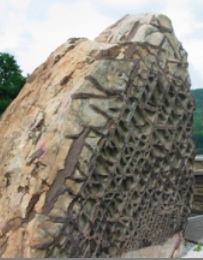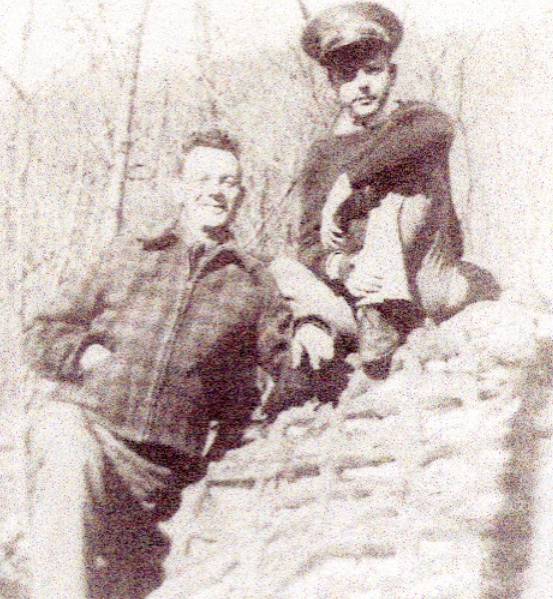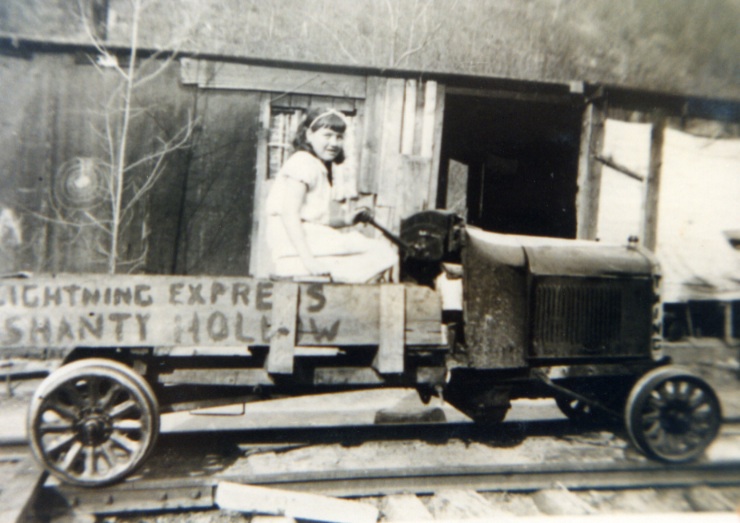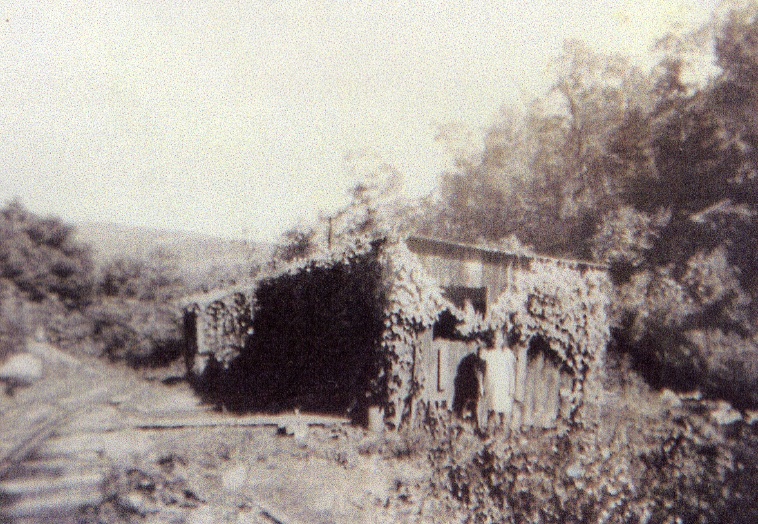


 |
 |
 |
| Betty Webster Bishop's Rock |
Original Location of Rock |
Read Story about the Rock Below: |
| Photo: New
Location
Near the Dam |
Photo:
Harold
Webster and Friend |
Photo:
Harold
Webster's
Railcar Invention |

| Photo: Betty's Shanty | |
|
The Rock and I
By: Betty Webster Bishop Long ago, in the hills of West
Virginia, there nestled a rock of questionable origin. This rock was
discovered by my Mother on one of our Sunday afternoon walks.
The rock in question, was at least six feet above the ground, and evidently several feet were embedded in the earth. It consisted of an uneven waffle type pattern, forming many geometric designs. The raised edges of this design were deep enough for adequate toe-holds for many feet that enjoyed scaling this mini-mountain. In following scenarios, I will attempt to picture the background and circumstances in which this discovery of the rock was made. Dad was a “logger” and he had to go where the timber could be found. Our permanent home was in Hambleton, West virginia, at this time. We often followed him from one timber area to another, and stayed with him during the summer months. This particular assignment appeared to be on a larger scale, so we “moved” to the back woods, amid virgin timber, near Shaw, West Virginia, located in Mineral County. Our “shanty” was a straight row of rooms, fifty feet long, made of upright boards. The construction left cracks at various intervals. Our first winter there, the snow would come through the cracks and pile up on the bedroom floor. One winter like that was enough. The outside was eventually covered with tarpaper---one of those “tar paper shacks” that folks laugh about today. (The floor was also covered with tarpaper where the wind had swept through before). My Mom was a “saver” and the one thing we did afford at that time, was the flour that came in 25 pound sacks. Those sacks were white on the outside and blue on the inside and were of very heavy construction. Mom had saved those over the months and by the time winter rolled around again, she had saved enough to paper several of the rooms. She had turned them inside out and the blue covering provided not only protection from the heat and cold, and wayward animals, (snakes in summer), but transformed those dark boards into a warm and cozy atmosphere. I do believe that before we moved in, the place belonged to any number of woods animals, including snakes, mice, possums, skunks, etc. The open doors to all the rooms were all aligned, making a perfect place to roller skate from one end to the other. I also recall water battles being fought from the roof, it being low and flat. (Water was furnished from a stream flowing behind the house). Buckets of water were left on the roof for the express purpose of attacking unsuspecting folks as they passed by. What a great childhood for a couple of kids who had no radio, television, and no car, but just home made board games and active and vivid imaginations. My sister was attending the University of West Virginia, at this time, so there was just my brother and myself. (I’m sure my Mom felt that was enough!) My brother was pure genius, even as a preteen, and devised many fun things to keep us occupied. I was a good follower, but managed to add a few weird ideas myself from time to time. The only way to town---which was a couple miles, and boasted a couple tiny stores and even tinier post office, with about a hundred residents---was by walking rails. We became very adept at this, as Rattle Snakes and Copper Heads would lie between the ties, and we chose not to disturb them. About the time my brother, Harold, reached thirteen, he discovered an old Model T that someone had discarded. It cost a whopping five dollars, so Harold talked the owner into letting him work for him to pay the tab. He adapted the wheels in such a way that they would fit the logging train tracks, and eventually got the engine to running. Now, we were big time, and the most popular kids for miles around. There was one problem---only one set of tracks and those were the ones used by the log train to transport the logs from the woods to the mill, a couple times a day. There was also one big advantage. Our Dad was the engineer of that train and he would warn us of this approach by the whistle long enough ahead of time for us to side track the “hoopy”, as the car was referred to. It later became known as “the Lightening Express”. This was a very appropriate name, since it’s top speed was 5 to 10 miles an hour. My appointed position---which gained me the privilege of even riding in the car---was to sit over the rear wheel and pour sand through a hole onto the rail when we approached an incline. This action gave traction to the wheels. All children love rides and this one was a real novelty. Even the adults got a kick out of riding. It wasn’t always convenient to ride the “Hoopy”. Besides, the gas cost about ten cents a gallon, and who could afford much of that? Riding was essential to our young group, so Harold built a “caterpillar tractor” for us to ride. This, he constructed of a long, wide, flat board and secured with a short upright board with a cross piece to hold on to. We would climb to the top of the hill---or mountain---sit on the board, hold on for dear life and slide down the trails left by the logs that had recently been cut, and slid to the bottom of the mountain for pick up. What a wonderful place to live and play. I don’t remember missing a thing---not even friends we had left behind in Hambleton. Several of those friends did spend a lot of each summer with us. They would catch the passenger train from our old home town and come over to spend time with us, and enjoy our new found activities. A couple of boys---13 and 14---even hitchhiked the 60 miles to be with us. In the meantime, we had made friends with the few children who lived in the area. Those friends remain today some 60 plus years later. My Mother was concerned, at times, because of the lack of exposure to a better culture and more genteel approach to life, but my brother and I agree that those three and a half years hold our fondest memories. I realize that I digress, but just the facts of the rock would hold little interest to other folk, and I do want the reader to picture this area and sense the importance of this rock in my life, then and now. Our Sundays were for worship and rest. The one allowed activity was a walk in the woods. It was on one of these walks that my Mother discovered “her” rock, as we often referred to it. She loved God and all aspects of nature, with a special fondness for rocks---large and small. She often found big, smooth rocks, and would write scripture verses on them---all through the woods, and even in the stream---where they would be visible to the loggers as they worked or passed by. I remember once when she waded out in the rushing waters to approach a large boulder. She wrote John 3:16 in huge letters. I’m sure no one missed that one. This big rock, the subject of my story, was her “pot of gold” at the end of the rainbow. She never tired of taking visitors to see it, whether local, or out of town. She called it “The Indian Rock”, but we later referred to it as “Mom’s Rock”. It was located a shot distance from our shanty, but well away from the tracks, deep in the woods, and some distance up the hill. Even though we lived in this forsaken (but NOT “God forsaken”) area, it didn’t deter visitors. It seems there was always someone going or coming. My folks had lived so many places over the years, and had acquired so many friends. There were some who were quite hesitant on their first visit to complete the trip once they came in view of our primitive way of life. It was quite intimidating to city folks. Oddly enough, once they arrived, they usually stayed longer than planned, and invariably made return visits. Some came for the novelty of the place. Others came for the close communion with nature. Mostly, people came for the fellowship my folks offered and their hospitality. As I stated earlier, my sister Naomi was attending college at the University of West Virginia. She says she doesn’t recall this, but I seem to remember her being a bit embarrassed at our living in the “boonies”. The way I remember it, is that she would try to discourage her college friends from accompanying her home for a weekend or college break. Once they did accompany her, they were captivated. After the initial visit of these “sophisticated” college friends, she was seldom allowed to come home without being accompanied by one of them. All who came were granted the privilege of visiting Mom’s “Indian Rock”. We felt it belonged to us and reveled in the sharing of it. Many spoke of it and the awe it inspired. Even after the many years and the many miles that separated us from it, we still talked about it. As children, the rock became the center of and the inspiration for our mental meanderings. At times, we were certain that ancient Indians had gathered here for “Pow Wows”, and the markings were secret messages or instructions left for other Braves to follow. We could almost see their ghosts rising from around the rock to engage in tribal dances. They would speak to us in a language we could understand. Other times, our scenarios took a different direction. At that time, we weren’t too versed in Egyptian history, but we had read enough to imagine that these were hieroglyphics left here by the ancient Egyptians for us to decipher. Maybe this stone was a misplaced part of a pyramid. Other times, other people, other worlds---all came together to enhance the lives of two small children in the West Virginia hills. It was a world of make-believe for us, but also it caused much speculation among the adults. The site of our dwelling was in itself, unique---not to us back then nor to other folks living in like situations---but now, as we look back and relive those times in memory and conversation, most of us are convinced that it was a unique place. Our shanty was situated between two hills---actually, two mountains. In back of us was a clear, sparkling mountain stream. This supplied us with our drinking water; also our cooking and bathing water. It was also the water supply for the little town of Shaw. (A very few of those “town folk” even had a faucet; and only two families had indoor bathrooms) Because the stream being the town’s drinking water, we were not allowed to play in it. That was Mom’s rule, but I’m afraid that type of rule was meant to be broken by two sneaky kids! Our bathing was done in an old tin tub, warmed in the summer by the sun and warmed in the winter on the old wood cook stove. No one was crazy about the Saturday bath, but taking it first was always an incentive, since the first to bathe got the clean water! Behind the stream, a mountain rose nearly perpendicular. A few feet from the front of our shanty were the tracks that carried the log train to the upper woods. It also carried our “Hoopy”. A narrow flat beside the tracks, ascended into another mountain. It had flat levels at several intervals where my Mom maintained gardens on three or four of these levels. Harvesting vegetable was no problem. They were collected and placed in “toe sacks” along the edge of the garden. The toe sacks were then rolled to each descending level until they reached the bottom. (Tomatoes weren’t included in this procedure!). The bags were picked up at the bottom, sorted and stored in the root cellar in the side of the hill. There was a trestle just above our place over the curving stream. It then followed the tracks back toward the mountain immediately behind us. The Rock was located in this area where the mountain hadn’t become too steep for climbing. We eventually moved from our little haven to a more---so called---civilized area and our rock and childhood was pretty much left behind. As we adjusted to our new environment (Tidioute, PA), made new friends and grew up, the rock was nearly forgotten. There would be those times, though, when something would jar our memories, and we’d recall those wonderful mental excursions conjured by that rock. Many years later---September, 1984, to be exact, I read an article in the Saturday Evening Post pertaining to strange rock formations found in several states. According to the author, there was much speculation among those researching these formations, but no definite conclusions. The rock of my childhood was immediately brought to mind and prompted my search for old pictures. Upon locating a fairly clear one, I wrote to the magazine, describing the rock and enclosing the picture. Having heard nothing regarding my letter, I assumed it didn’t hold enough interest to take note. The issue was once again forgotten. In the meantime, my brother took a trip back to West Virginia. By this time, we lived in the West Palm Beach, FL. area. He had decided to make the trip to visit old friends who had relocated---that necessity being due to the fact that our valley had become a huge lake. It was the result of the dam that had been built to the south on the Potomac River. I was made aware of this possibility several years prior to its becoming a reality. I was saddened to think that the mystery of “our” rock may have been forever buried beneath the massive lake. It certainly was not forgotten by the many who had viewed it. When I received my December 1984 issue of the Saturday Evening Post, I was surprised and pleased to see my letter published, along with the picture I had sent. I proceeded to show everyone the article which, once again, evoked so many wonderful memories; all the while explaining and retelling my story. My brother returned from his trip soon after this and his first words to me were, “Guess where the Indian Rock is”. Had I not been so recently reminded of this rock, I probably would have thought it strange that he would even mention it. He informed me that it had been rescued and placed as a monument at the entrance of the beautiful Bloomington Lake Park---the lake which now covers our shanty and so many memories. (The lake and park were later named for Jennings Randolph, I am told). I was overwhelmed with this news but had mixed emotions. I was very happy that someone else recognized that the rock was something special and I was happy that it had not been buried as I had feared. Yet, the news of its salvation also brought feelings of loss. The rock had been so personal; almost like a family possession; but now it had become the property of everyone. I was glad and sad at the same time; feeling a wee bit jealous that “my rock” was no longer “my rock” exclusively. In April of 1985 I picked up the Saturday Evening Post, and scanned the “letters to the editor” page. There was a different picture of my rock---then, my name jumped out at me as I read the article accompanying it. That really got my attention. It was a letter from Col. Martin W. Walsh, Jr., Corps of Engineers Commander, in Baltimore, Md. His letter was in response to my earlier published one. The following is a quote from his letter concerning said rock. “Speculations range from the impressions of the skin pattern of a giant reptile, to evidence of space travelers on earth. (Had Harold and I known of space travelers as kids, we really could have taken some mental trips!). (quote continued) Upon examination by geologists from the U. S. Corps of Engineers and other agencies, it was concluded that the rock is a natural geologic formation. The rock is locally called “waffle Rock” because it looks like a giant, oversized waffle. This large boulder is on display at the Corps of Engineers Bloomington Lake Visitor Center in Mineral County, West Virginia”. End of quote. He goes on to say how the sand (deposited by ancient streams) consolidated into sandstone with layers of rock above and below being compressed into these large folds. They calculate that it occurred about 250 million years ago during the formation of the Appalachian Mountains. He gives more detail, but the above information provides the gist of his response. My sister, Naomi Cross, visited the area several times after this information was garnered. On one of these trips, a friend took her to a site where a similar rock had been discovered. It was higher up on the mountain above the water line, but almost directly above where “our” rock had been. Again, speculation has it that this one and ours were once a part of the whole. They believe that some violent upheaval caused a part to be broken away and relocated at the site where “our” rock came to rest. She chipped off several small pieces and brought them to me. They are a personal treasure of mine and my very own bit of history. It is my hope to one day make this trip and see again this old friend of mine which has evidently withstood all elements for the past 250 million years. While it holds such a strong fascination for me, I’m sure those who visit and view this piece of the past will come away with a feeling of awe and will be affected in some way with its mystery and majesty. It would be interesting to know who instigated its rescue. I know the Corps of Engineers made the final decision and performed the task of excavating, removing and placing it at its present location. What I’d like to know is, who originally determined that it should be preserved. Was it an area resident, for there were very few who didn’t know of its existence by the time we left there? Was it one of them who remembered it, or was it discovered by a geologist, a member of the survey team for the project? Was it one who was impressed enough to insist that it was worth the effort and problems involved to remove it? Just curious, but still personal, and I believe the facts would be of interest to the public. Again, I must say that I am so thankful that the rock has been rescued, studied and preserved for the millions of visitors to the Park to speculate and enjoy. For those who are interested in vacationing in such a beautiful area of the country where the scenery and serenity will take you back to “how life used to be”, this would be worth the visit. But even those who are merely interested in geology or those who just plain love rocks, you, too, are in for a real treat. As stated earlier, this boulder is now known as “Waffle Rock”. Certainly that is descriptive, but that name and all the conclusions drawn by the experts lacks the awe, mystery, and intrigue that surrounded our “Indian Rock” of the 1930s when it was ours and ours alone. (I remain unconvinced that “they” are right)! |
|